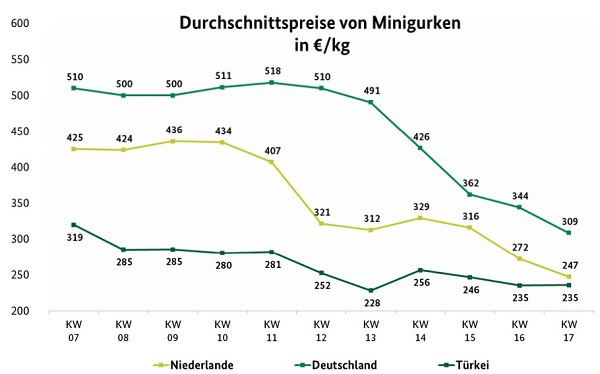The assortment of snake cucumbers was primarily composed of Belgian, domestic and Dutch batches, with domestic products completely absent in Cologne. Spanish batches did not go beyond a complementary character and were still arriving exclusively in Munich. Availability had not changed significantly; it was by far sufficient to meet demand. Demand was not particularly strong. This often resulted in further declining quotations, as distributors wanted to keep their surpluses as small as possible.
It was not until the weekend that distributors were able to raise their demands slightly again in some places, as storage facilities had improved somewhat. In the case of mini cucumbers, priority was given to Dutch and German deliveries. Imports from Turkey, Belgium and Spain played only a minor role. In this market sector, too, concessions were omnipresent; in most cases, a somewhat too abundant supply was the decisive factor, reports the BMEL.

Photo: BMEL
Apples
Domestic offerings still predominated: Elstar, Jonagold and Braeburn formed the basis of the product range. So far, however, only Chilean varieties have participated in the event: Royal Gala and Elstar have not been very popular so far, as they are more expensive than the European competition, which continues to be convincing in terms of quality.
Pears
South African batches dominated the scene: with Packham`s Triumph, Trout, Cheeky, Abate Fetel, Rosemarie and Williams Christ, a large number of varieties were available. Argentine and Chilean deliveries lost slightly in importance overall. Among the European products in storage, Italian Abate Fetel in particular was available.
Table grapes
Imports from South Africa apparently predominated. Supplies from Chile, Peru and India supplemented events with rather small quantities. There was relatively little activity: availability was sufficient to meet demand, which was not particularly strong. In terms of prices, very little movement was discernible.
Strawberries
Italian, Dutch and Spanish fruits obviously formed the basis of the supply. Greek and domestic offers followed in terms of importance, Belgian products complemented the trade. In terms of quality, there was hardly anything to criticize: Coloration, size and taste appealed sufficiently. The interest increased, although the typical April weather had also limited the storage possibilities in some places.
Lemons
Spanish Primofiori dominated. Unloadings from Turkey, Italy and Greece rounded off the product range, but by no means appeared on all markets. In Hamburg, the South African campaign began: €25 per 15-kg carton was the price. The arrival of the first Verna from Spain is expected soon.
Bananas
Supply and demand balanced each other out sufficiently for there to be price changes only in the rarest of cases. Only in Frankfurt did second brands become cheaper, while prices for third brands rose slightly. In Munich, the first brand became slightly more expensive.
Cauliflower
French batches predominated. The presence of Italian and Spanish batches had apparently reduced. Dutch products supplemented, and domestic ones opened their season with small quantities. Overall, availability had become limited, and demand could not always be fully met.
Salads
Spanish iceberg lettuce was available almost as a monopoly, flanked only locally by domestic batches. The quality was not always convincing, which is why a wide price range was established, especially in Frankfurt and Hamburg. The presence of colorful lettuces from Germany grew strongly, which in turn had a negative impact on prices.
Tomatoes
The assortment was dominated by panicle tomatoes, which came primarily from the Netherlands, Belgium, Spain and Turkey. Cherry tomatoes came mainly from the Netherlands and Italy, supplemented by domestic offerings. In the case of round tomatoes, Turkish, Spanish, Belgian and Moroccan products could be specifically accessed. The presence of domestic fruits had intensified a little.
Sweet peppers
Dutch batches predominated. Turkish, Belgian and Spanish supplies followed in terms of importance. Local products appeared only sporadically. In Munich, there were also Hungarian imports, which were easily accommodated. Overall, prices showed a downward trend.
Asparagus
Domestic offers obviously dominated the event. In the sector of white and purple spears, Greece and the Netherlands in particular completed the scene. In the sector of green asparagus, Spanish and Italian products were the most likely to be found. The long weekend and the good weather prospects brought further momentum to the marketing. In some places, therefore, a complete clearance succeeded.
Source: BMEL
